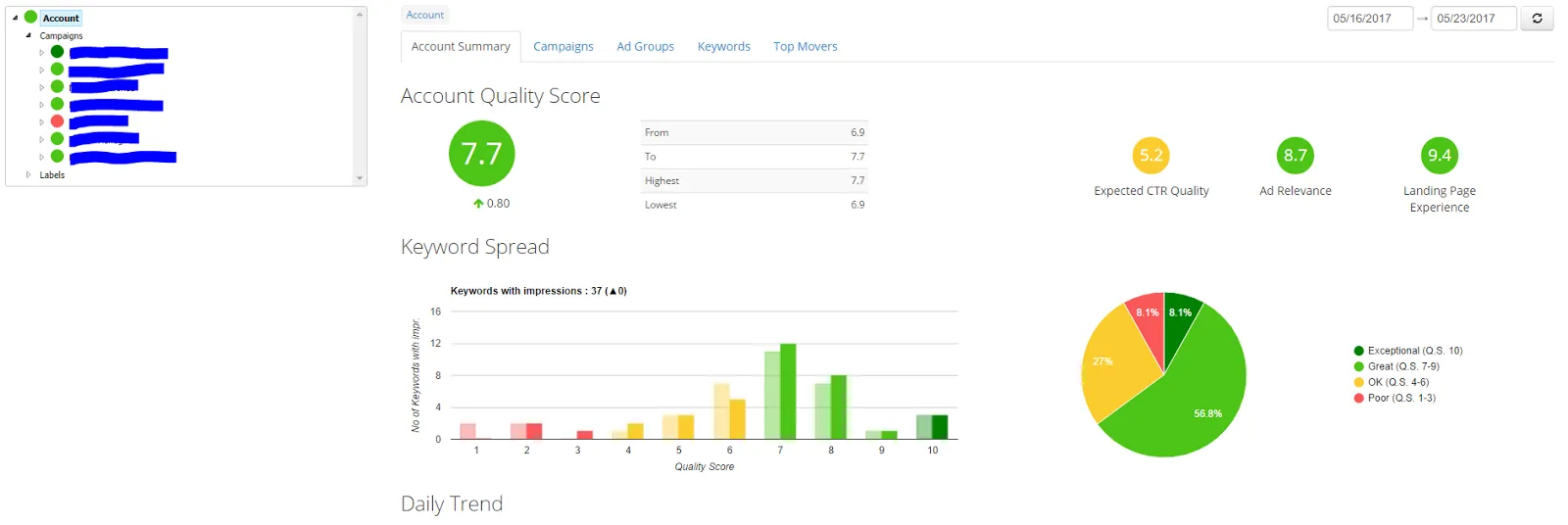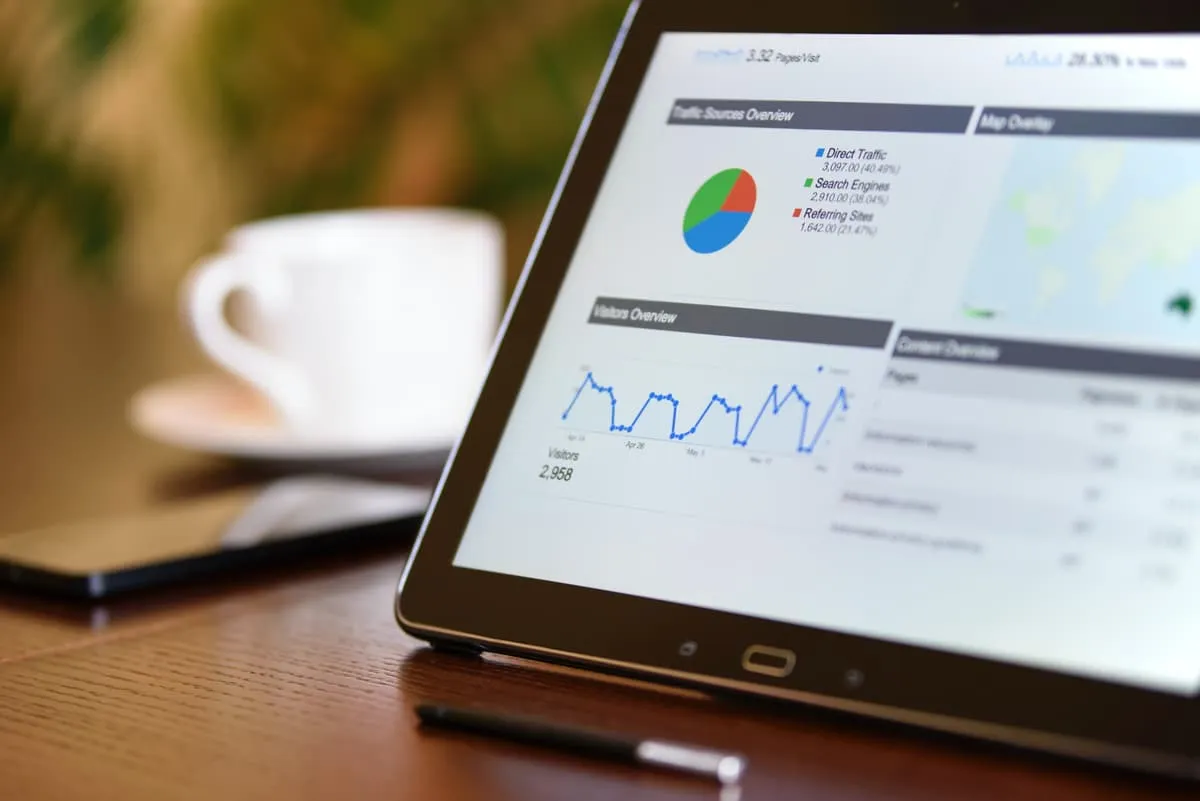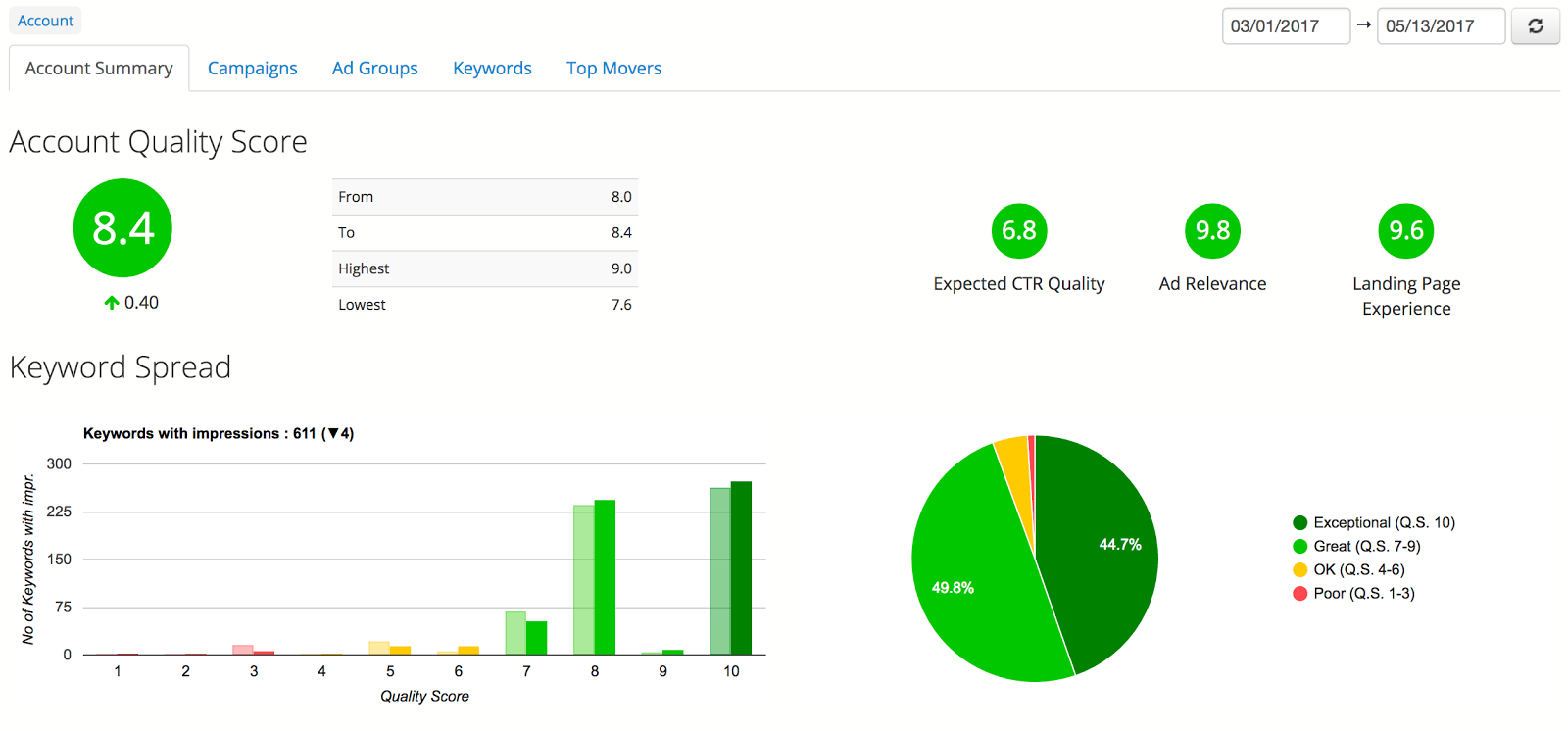You’ve done your keyword research, narrowed down your top keywords, written compelling ad copy, and created a great landing page for what you’re selling. But you find out your Quality Score is below average.
Improving your quality score increases your ad’s position and as a result, increases its landing page visibility. It’s also an indicator that your ad is relevant and doing well.
Is Quality Score Still Important in 2022?
Yes! Here are 3 great reasons why quality score still affects your ads:
- Quality Score was and continues to be the key way to understand what Google thinks of the quality and relevance of your ads.
- Automation backed by machine learning delivers good results, but it can’t do much about relevance problems, so focusing on relevant ads will improve your performance further.
- A better Quality Score always has and always will help you save money.
Time to move on to the meat and potatoes of this post. Don’t worry though, I’d never leave you hanging.
5 Ways to Improve Quality Score
1. Use Optmyzr’s Quality Score Tracker
That’s not to say that you can’t use what Google gives you, but our team uses Optmyzr to track our quality scores. Why? Because when you have as many accounts as we do (I work for a digital ad agency) with dozens of campaigns, ad groups, ads, and keywords in play at the same time, we need all the help we can get in order to quickly pinpoint the areas we need to focus on the most.
We’ve worked the Quality Score Tracker into our daily process and our clients are way better off because of it. We’ve also learned that this is a great tool to show clients. Granted, there is some debate out there about whether quality score is a good metric to show a client or not but with the way we do things, it’s great.
We like to teach our clients because we believe that a learned client is a lifelong client and, as long as they understand what kind of return on ad spend (ROAS) they are getting, one who understands the benefits of larger paid search budgets
Below is a real screen-shot of a dealership client of ours:

Right off the bat, we can see where the issue is. Overall, the account quality score is good at 7.7 but as we all know, there’s always room for improvement. That red circle on the top left stands out, doesn’t it?
Clicking into it we can see the offending ad group in addition to the offending keywords. We can even see the quality score over time. Below where it says Daily Trend (bottom of image) there is a line graph that tells you exactly when the quality score dipped.
Armed with that knowledge, I’m able to go into Google Ads and see that the ad was wrong. While the ad had been changed to include the year of the vehicle, the keywords for this particular ad group didn’t include that information.
Since the keywords being bid on didn’t match the ad and, of course, the landing page when the ad was clicked on didn’t match the ad, the quality score went down.
This took just a few minutes to find and then correct.
2. Use Long Tail Keywords – Expected CTR Quality & Ad relevance
Competitive keywords can be difficult to manage in both organic and paid search, especially in the more competitive industries, which is why you should always be picky about the keywords you use. With long-tail keywords, you can be more specific and specificity equals a higher conversion rate, less cost per click, and a higher expected click-through rate.
If you really want to take the whole superhuman CTR thing to the next level then think about using single keyword ad groups (SKAGs). True, these may take a bit more work to implement but your CTR will thank you.
There are more than a few reasons why you’d want to take a closer look at SKAGs and I encourage you to if you aren’t familiar with them or haven’t tried them yet. One of the main reasons why SKAGs work so well is because they are so very relevant. Using SKAGs you can ensure that every keyword used (don’t forget about long-tail here) is in the ad copy of the ad.
Yes, you can use dynamic keyword insertion for this, but for more flexibility, try SKAGs.
Negative keywords are your friends. For some reason, negative keywords are easy to overlook, but they should be paid close attention to. The search term report will show you the holes that need to be plugged. Plug them, but keep checking back to make sure another leak hasn’t sprung.
3. Use EVERY Ad Extension possible – Expected CTR Quality & Ad relevance
I see a lot of accounts once we take them over from another agency and it always confuses me as to why more ad extensions aren’t used. Not only do they give your ad more bling, but they also take up more space (this is really good on mobile), increase relevancy and drive up the click-through rate.
I understand that not all ad extensions will be relevant in every case, but use all that makes sense. Yes, some are more time-consuming than others but the more you use the better your ads will perform.
Take a look at the price extension. Can you use it? Then do it. It takes up a ton of space on mobile and can really drive your competitors down. Recently, Google announced that price extensions are now available on all devices.
Again, they take up a lot of space and, on desktop, look really cool. Need more of that bling I mentioned earlier? Well, here you go.
Also, make sure that you’re at least using location extensions (if you have a physical location), call extensions, structured snippets, site links, call-outs, and the message extension.
Sound like a lot? This is just the tip of the extension iceberg, make sure to use as many as you can. When it comes to extensions, remember that more specific is better. What I mean by that is that you can add account-level extensions but you’ll see better success if you narrow it down to the campaign level or, better yet, the ad group level.
Just remember to keep your eye on the prize, a better quality score.
4. Ongoing Ad Optimization – Expected CTR Quality & Ad relevance
One ad per ad group isn’t enough, neither are two. Google recommends at least 3 per ad group. The best way to get the best performing ads is by doing A/B split testing, even if you are using SKAGs. Also, think about copywriting and how you can turn a boring ad into a more compelling ad that invites a click.
The best way to ensure that your ads are highly targeted is to always write each one from scratch. Never stagnate, always try to beat your best performing ads by writing even more compelling copy for the next ad.
If you have long-tail keywords going to a highly converting ad then you are well on your way to increasing your click-through rate and your ad relevance.
5. Take a long hard look at your landing pages – Landing page experience
You wouldn’t send an ad about toothpaste to a page selling candy, would you? Rhetorical question, but sometimes it takes an absurd question to drive a point home. My point is that you should be as obsessed with making your landing page match the ad as you are about the ad matching the keyword.
That’s a great start but you need to go further than that.
First, make sure the landing page looks just as good on mobile as on desktop. Pay close attention to the speed of the page because Google has gone on record saying that 53% of smartphone users will abandon a web page if the site takes more than 3 seconds to load.
3 Seconds! Couple that with a recent study that shows we have an average attention span of just 8 seconds (1 second less than a goldfish) and you have a recipe for disaster if you aren’t careful.
While I won’t be going into depth about landing pages in this post I think it’s important to ensure that your landing page has a call to action. What’s a call to action? Anything that gets people to act on whatever it is that you want them to do. It can be a lead form submission, a download, a phone call or even watching a video.
Whatever it is it has to be very easy to do. Making people jump through hoops won’t lead to conversion. Having said that, if it’s not feasible to put the final call to action on the actual landing page, then you must make sure that your site is easy to navigate with a clear path to your desired conversion.
Take a long hard look at your landing page data and pay particular attention to what is happening in analytics. Are they converting? Are they following the path you’ve laid out for them? If not, why not? Take a look at the data from both the desktop and mobile perspective, is anything off? If so, fix it.
Don’t stop there
Keep optimizing. Don’t let your account, or your client’s account, slowly die. Stay active, make adjustments regularly, and become obsessed with raising the bar. Never stop until the bar is as high as it can possibly go. There has been a lot of talk over the years, even research done on the importance of account activity. So, stay active my friends.
This is a guest post. The views and opinions expressed by the author are solely their own and do not represent that of Optmyzr.








